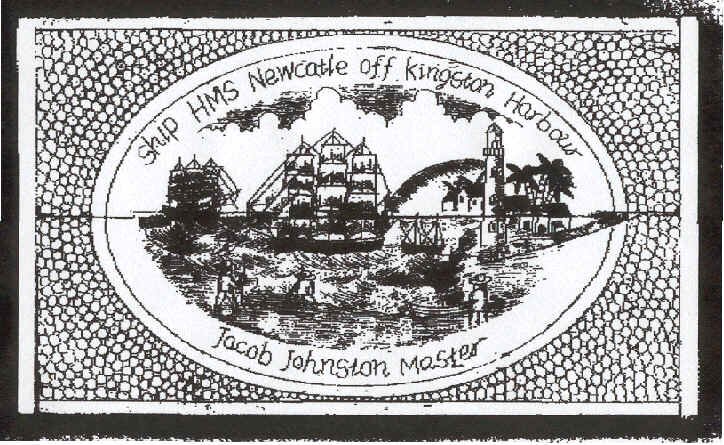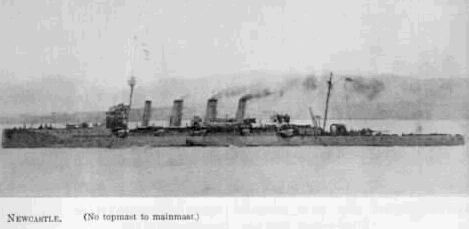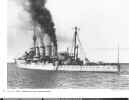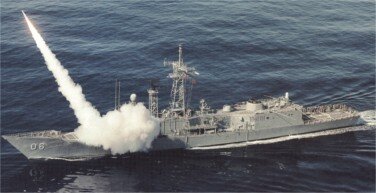Ships Past and Present
|
|
| 2015 | ||
|
|
HISTORY
Seven "Newcastle's"
IT IS NO EASY TASK to write the history of the ships which have borne the name "H.M.S. Newcastle." Just look at the battle Honours. Lowestoft is all right: we all know where that is. But Negapatam? Sadras? Porto Farina? Just find them, let alone say what happened there. But let us put down all we can find out here and now, and when we get back to our favourite seat in the British Museum we can with greater strength conquer the rest of the story. After all, the motto of the ship is "Fortitudino Vinco" (I conquer through strength). Even so, "M.L." does not mention a single Newcastle in his book, nor does "C.L." So that means that we are not going to learn much about the details of the ship—she kept her deeds pretty dark.
Nevertheless, number one, a fourth-rate frigate of fifty-four guns, had a reasonably exciting time. Built by P. Pett at Ratcliffe in 1653, she was responsible for half our battle honours. As a Cromwellian ship she was with Blake when he sailed into Porto Farina, Algiers, and sank the fleet of the Barbary pirates there. She was also with him when he sailed under the noses of the Spanish gunners at Santa Cruz in the Azores and cut free the treasure ships from Mexico. Not a bad start.
Later on, England was involved in trade wars with the Dutch, and off Lowestoft and Orfordness, by Harwich, Newcastle saw battle. The Duke of York, head of the Admiralty and brother of the King, led the fleet with a long series of very cunning manoeuvres in the first battle. On the whole we did rather well, sinking twenty-five of the enemy, but the Duke’s critics declared that he had not fought enough, and it was felt politic to preserve his dignity by setting him on land for the rest of the war. Seven years later, at the battle of Texel, Prince Rupert led the fleet against de Ruyter, but as his second-in-command, Spragge, would insist on fighting a personal battle with Tromp, the whole affair became a mêlée from which we extricated ourselves just in time. Previously in the same year, at Schooneveld, we also had rather the worst of it, and so we were glad when 1677 brought the end of the Dutch Wars. After this we turned our attention to France, and in 1695 Newcastle helped to capture two French frigates. Unhappily she foundered off Spithead during a storm in 1703.

Engraving on a Tusk
By kind permission Cindy Crawford USA
The second ship of the name was also a fourth-rate frigate of 54 guns. She was built at Sheerness in 1704 and was soon in action with convoys in the Mediterranean. In 1705 she helped Admiral Leake to crack a French convoy, which was heading for the final assault on besieged Gibraltar. Six years later she was in action in the West Indies, and in June1717 Sail for Newfoundland convoy duty returned1718 again in1719 convoy duty this time to the Mediterranean then transferred to the Med squadron under the command of Admiral Sir George Bynt Nov 1720 command of the squadron given to Capt Scott. Jan 1721 transferred to the Plantation Squadron Barbados. Oct 1721 returned home and paid off. she returned to service in 1734 when she was sent to the Plantation Squadron out of Jamaica 1734 to 1736 she patrolled the Leeward Islands ordered home May 1736. 1738 she was refitting to go to the Med to serve under Admiral Haddock she served there until 1740 when in June she was ordered to patrol the entrance to Ferol to watch the Spanish Squadron and was instructed if any ship left she was to follow it and report it's destination to England , she continued in the channel until 1742 when she was sent to the med to serve under Admiral Roch finally returning home in May 1745. she was sold in 1746
Only four years later the third ship, larger but no more powerful, was launched at Portsmouth. During the Seven Years War she saw service off Madras in India, helping Clive in his conquests. In 1758, off Cuddalore (Sadras), Newcastle was engaged, but her captain was dismissed for not supporting his Admiral. Fortunately her next captain, Colville, did well in small actions against the Frenchman, d’Ache, off Negapatam and Porto Novo, Pondicherry. Just two years later he was killed and the ship was wrecked in a hurricane in 1761
Then, for fifty-two years, no ship called Newcastle existed, until a war against the U.S.A. forced us to build a fast frigate in 1812 to match the North Atlantic raider Constitution. She was larger than the previous ships, being of ~ tons, yet she carried the same number of guns. She did very little and was soon condemned to a life of inactivity and finally sold in 1850.
The fifth ship was an interesting one, as she was a screw-frigate, able to -steam or sail. She was laid down at Deptford and launched in i86o. Of 4,020 tons and thirty-one guns, she sailed with the Flying Squadron of 1874-7, but spent most of her life as a powder hulk.
In 1909 the sixth ship was listed as a second-class cruiser. Armstrong-Whitworth built her of 4,800 tons with two 6-inch and ten 4-inch guns. She was a very fast coal-burner capable of twenty-five knots, and she spent most of her life on the China Station. There she was when the Chinese Revolution broke out under Sun Yat Sen. But in 1914 she moved over to Esquimault and spent the war off North and South America vainly searching for the German raider Emden. In 1931 she was sold.


NEWCASTLE 1909-21
Built by Armstrong, Elswick. Laid down 14.4.1909. Launched 25.11.1909. Completed 9.1910. China 1910-14 (replaced Bedford)—Shanghai Rebellion 23.6.1913. Searched off S. America for German AMC Prinz Eitel Freidrich,1914.Pacific1915-16—captured German prize Mazatlan,1916. Mediterranean (Mudros, East Indies, Adriatic) 1917. SE Coast of America 1918-19.Nore Reserve 1919-20. Sold 1921, Ward, Lelant.

NEWCASTLE 1936-58
So we come to our ship, the seventh Newcastle, built by Vickers-Armstrong, and launched in 1936 at Newcastle by Her Grace the Duchess of Northumberland. During the early part of World War II she patrolled the North Atlantic and Norway, steamed to assist the Rawalpindi, helped Plymouth during the Battle of Britain, and damaged two German destroyers off Brest. She also created an unwelcome record by staying continuously at sea for 126 days (Wanchai Warriors please note). Moving to the Mediterranean in 1940, she took part in an abortive action under Vice-Admiral Somerville against the Italians off Cape Spartivento, during which her boilers were held to be untrustworthy. After duty in the South Atlantic, against blockade-runners, she was in the East for a while in 1942 before returning to the Mediterranean for convoy duty to Malta. There she was torpedoed by an E-boat and had to be repaired in the U.S.A. She rejoined the Eastern Fleet at Ceylon and acted as the flagship to the Fourth Cruiser Squadron. She bombarded a number of Japanese-held islands and supported the Fourteenth Army in Burma. Since then she has been completely re-modernised in 1952 and seen action, of a not very exciting nature, off Korea. 1954/55The First Ship to recommissioned by air (via India and Cyprus in a slow Britannia a/c) Now she, too, has reached the end of her life.
HMS-Newcastle 1978-2004
HMSNewcastle is a Type 42 Destroyer which entered service in 1978 and her primary role is to provide air defence for task group operations.
Powered by Rolls-Royce Olympus and Tyne turbine engines she has controllable pitch propellers and stabilisers. She is fitted with the latest sensor and communications equipment.
With a standard displacement of 3.500 tonne, she is 125 meters in length and 14.3 meters wide and a complement of 280
Armament includes 114 mm gun, Sea Dart missile, anti-submarine torpedo tubes and a Lynx anti-submarine helicopter
HMAS NEWCASTLE


HMAS NEWCASTLE HISTORY
General Information:
Launched 21 Feb 1992 Commissioned 11 Dec 1993
HMAS NEWCASTLE is a long range escort with roles including area air defence, anti-submarine warfare, surveillance, reconnaissance and interdiction. The ship is capable of countering simultaneous threats from the air, surface and sub-surface. Powered by modem gas turbines, the ship can be underway from cold in 30 minutes. In addition, two forward mounted retractable auxiliary propulsion units provide a secondary means of propulsion plus excellent manoeuvrability in confined waters. HMAS NEWCASTLE’s principal weapons are the Standard medium range air-to-air missile and the Harpoon anti-ship missile. The ship is also equipped with a 76mm gun, a Phalanx close in weapon system, and two triple torpedo tubes. For long range anti-submarine tasks the ship is equipped with flight deck hangars for two S-70B-2 Seahawk Helicopters. The ships sensor package includes long range radar's for air and surface surveillance, and is the second FFG to be fitted with the Australian designed and built Mulloka sonar.
HMAS NEWCASTLE is named after the City of NEWCASTLE, located 200 km North of Sydney, New South Wales. Since Commissioning, the crews of NEWCASTLE have maintained a close relationship with their namesake City. At least one visit to Newcastle city is conducted each year and the ship actively supports its adopted charity organisation, the HUNTER ORTHOPEDIC SCHOOL. A recent visit over the Australia Day weekend (26 January), was a huge success with the ship inundated with visitors and a Freedom Of Entry march through the streets of Newcastle.
Pictured here, the new Commanding Officer of HMAS Newcastle Cdr. Justine Jones, with a brief outline of his bio.
Commanding Officer
Commander Justin G. Jones, RAN was born in Adelaide, South Australia. Educated at Geelong Grammar School, he joined the Royal Australian Navy in January 1988 and is a graduate of the Royal Australian Naval College and the Australian Command and Staff College. He holds a Master of Management Studies, a Master of Arts (Strategy and Policy) and a Graduate Diploma in Defence Studies. He is currently reading for a Master of Maritime Studies.
Cdr Jones is a Principal Warfare Officer with specialisations in surface warfare and advanced navigation. His early years at sea included service in HMA Ships Stalwart (II), Jervis Bay, Brisbane and Success while under training; and HMA Ships Bunbury, Westralia and Hobart as an Officer of the Watch. He later served in HMA Ships Wollongong, Sydney, Arunta and Manoora as Navigating Officer. Highlights of these years include representation at the 50th Anniversary of Indonesian Independence Fleet Review in 1995, completion of the inaugural RAN Advanced Navigation Course and commissioning of HMAS Arunta in 1998, the first RAN warship visit to Ho Chi Minh City (Saigon) since the Vietnam War in 1999, counter terrorism support for the Sydney 2000 Olympics and two operational deployments to the Solomon Islands supporting the peace monitoring process throughout 2000-01. CMDR Jones served as Executive Officer of HMAS Parramatta from late 2004 until mid 2006, a period which included a six month operational deployment to the Arabian Gulf supporting the rehabilitation and reconstruction of Iraq. This deployment resulted in the award of a Meritorious Unit Citation to Parramatta for meritorious service in the Gulf.
Cdr Jones’ staff postings have included serving as an instructor at the Navigation Faculty of the RAN Surface Warfare School, two years exchange with the Royal Navy as Staff Warfare Officer (Navigation)2 to Flag Officer Sea Training in Devonport, Plymouth, and as Operations Officer to Commodore Flotillas/Commander Deployable Joint Force Headquarters (Maritime). In 2006-07, he served as Commander Fleet Plans within Fleet Headquarters where he was responsible for fleet operational planning, exercise management and operational level international engagement, before completing the Australian Command and Staff Course in 2008.
Cdr Jones was awarded the 2006 Vice Admiral Viscount Nelson KB Trafalgar Bicentennial Sword of Excellence for leadership, and is the inaugural recipient of this award.
Cdr. Jones is a Fellow of the Australian Institute of Navigation, a Member and Councillor of the London based Nautical Institute, a Member of the Australian Naval Institute and the Royal United Services Institute. He is also an Honourary Member of the Nelson Society of Australia.
Cdr Jones is a regular columnist for Seaways, the International Journal of the Nautical Institute, and also contributes to Navigation, the Journal of the Australian Institute of Navigation.
Cdr Jones’ academic interests lie in maritime strategy and sea power, particularly relating to the Indian Ocean. His other interests include a life long passion for football (soccer), watching rugby, water skiing and collecting naval antiques and memorabilia.
Cdr Jones is married to Terrie. They have two daughters and reside in Sydney.
Cdr. Jones took command of HMAS Newcastle on 19 December 2008.
The interesting addition to my Bio, which I hope members will enjoy, is that HMS NEWCASTLE (D87) was the first ship that I stepped onboard as the new FOST SWO(N)2 in late 2001 when arriving on a two year exchange. I have here in my cabin a photograph of HMS NEWCASTLE, signed by the then CO, Cdr Pearson. I then spent a week in NEWCASTLE in 2003 assisting the Navigator during that year's Spec N training course. So, some previous connections to HMS NEWCASTLE !